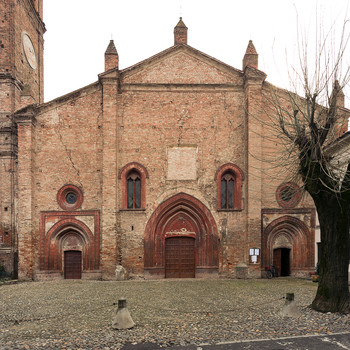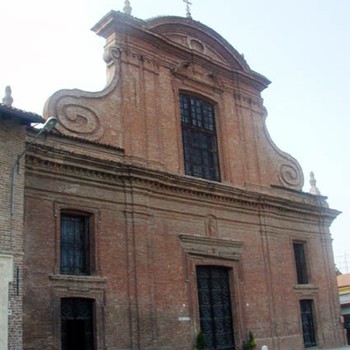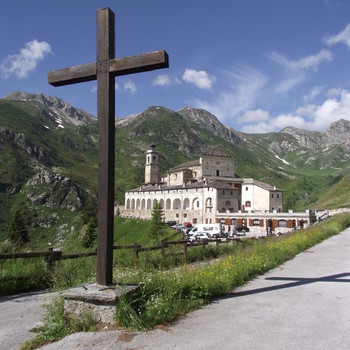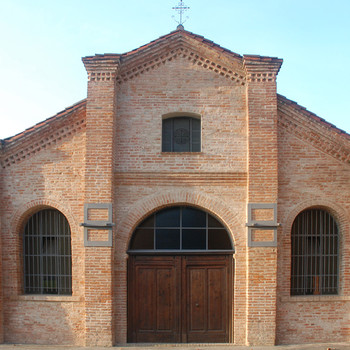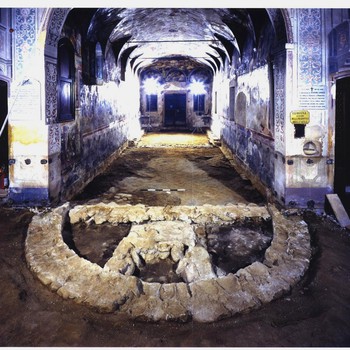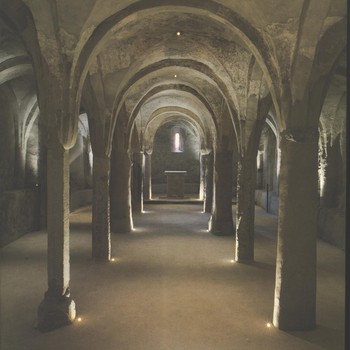Chiesa di Santa Maria e San Siro - Santuario della Madonna della Guardia
Diocesi di Tortona ( sec. XII; XIV )
La Chiesa di Santa Maria e Siro è un significativo esempio di architettura gotica databile al XV secolo, al suo interno è visibile un importante apparato decorativo ad affresco riconducibile alla metà del Quattrocento.
Chiesa dei Santi Maria e Remigio
Diocesi di Alessandria ( sec. XVIII; XIX )
La chiesa barocca dei Santi Maria e Remigio a Pecetto di Valenza risale alla prima metà del XVIII secolo. La struttura assorbì parte di un precedente edificio intitolato a S. Maria Vetere eretto nel X secolo.
Chiesa di Santa Maria della Corte
Diocesi di Alessandria ( sec. X; XV; XVII )
La chiesa di Santa Maria della Corte in Castellazzo B.da è citata per la prima volta nel 1005. Ad aula unica, è ricostruita nel 1494 a tre navate in stile tardogotico, e nuovamente tra il 1665 e il 1717.
Santuario di San Magno
Diocesi di Cuneo-Fossano ( sec. XV; XVIII; XIX )
Il Santuario di San Magno venne costruito nel XV secolo sopra un altare dedicato al dio pagano Marte, venerato dai Romani come dio preposto alle attività dei campi, ai confini e alla attività bellica che poteva assicurarne la difesa.
Chiesa di San Rocco
Diocesi di Alessandria ( sec. XVI; XVIII )
La chiesa campestre dedicata a San Rocco risale al XVI secolo quando fu edificata su un precedente edificio nelle sembianze attuali, e custodisce un pregevole ciclo di affreschi nella zona absidale.
Chiesa di San Rocco
Diocesi di Alessandria ( sec. XVIII )
Ricostruito nel 1779 su preesistenze romaniche, l'edificio appartiene al maturo barocco piemontese. Interessante soprattutto l'impianto dell'interno, valorizzato dall’organo storico Lingiardi, e arricchito da diverse opere pittoriche.
Chiesa di Sant'Alessandro
Diocesi di Alessandria ( sec. XVIII; XIX )
La chiesa di S. Alessandro è una delle migliori espressioni dello stile barocco alessandrino, progettata da Domenico Caselli, realizzata grazie alle elargizioni di due vescovi alessandrini fratelli, Francesco e Gian Mercurino Gattinara.
Chiesa di San Francesco
Diocesi di Acqui
Di grande impatto visivo, l'edificio oggi ospita il Museo ecclesiastico di proprietà comunale.
Chiesa di San Giovanni
Diocesi di Acqui ( sec. XIII; XIV )
La chiesa di San Giovanni fu l’antica parrocchiale dell’abitato di Roccaverano. Vi è attivo il Maestro di Roccaverano.
Santuario della Madonna dei Boschi
Diocesi di Cuneo-Fossano ( sec. XII; XV; XVI )
Un sito di antica devozione racchiude al suo interno preziosi cicli di affreschi databili dal XV al XVI secolo, tra cui un Giudizio Universale.
Chiesa di San Dalmazio
Diocesi di Alessandria ( sec. XI; XIII; XVI )
La prima chiesa di San Dalmazio fu consacrata da Papa Pasquale II nell'anno 1110. Distrutta dal Barbarossa, fu ricostruita dal 1270, per concludere le navate laterali solo fra il 1560-1576. Ha un'originale facciata neo-gotica a fasce.
Museo dell'Abbazia San Dalmazzo di Pedona
Diocesi di Cuneo-Fossano
Il museo dell'abbazia è il traguardo di dieci anni di lavoro nella chiesa parrocchiale di San Dalmazzo che dal medioevo fu fulcro di un monastero benedettino di straordinaria importanza
Fresco Cycles

Frescoes are an Italian invention that combine the skilled preparation of walls with the mastery of the painter. In a single day (“giornata”) a fairly large area of “intonaco” (the final layer of plaster) can be painted “a buon fresco”. The paint penetrates the plaster, becoming a permanent part of the wall, unless problems arise and these would be due mostly to inadequate roof maintenance. Only in Italy have some artists been designated with names that relate to their ability to paint quickly: “fa presto” [works quickly] or “presto e bene” [fast and good]. Proof that the Piedmontese were equally skilled can be seen in the ancient paintings brought to light in the attic of Sant’Orso, in Aosta, and in Mattia Bortoloni’s magnificent decorative cycle for the Sanctuary of Vicoforte, but we might also mention Jaquerio in Ranverso, Spanzotti in Ivrea, Gaudenzio and Tanzio in Varallo, Pozzo in Mondovì, and Aliberti in Asti).



